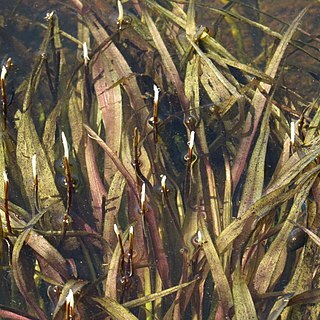Monoecious, acaulous. Leaves radical, sheathing at the base, 10-150 by 0.5-1 cm; nerves 5-9, parallel, connected by very thin cross-veins. Peduncles 1 or more, 10-40 cm, often much longer. Spathe 1-flowered, up to 10 cm, tips obtuse. Flowers bisexual. Sepals linear, 7-15 mm, 1-nerved, apex cucullately contracted, margin scarious. Petals 10-12 mm. Stamens 3; filaments 3-6 mm; anthers linear-lanceolate, 1-2 mm. Ovary as long as the spathe; rostrum 3-10 cm, sometimes longer; styles compressed, 6-10 by 0.5 mm. Fruit linear, 3-6 cm. Seeds ∞, elliptic to ovate, 1-2 mm, testa with 8 longitudinal more or less but distinctly tubercled ribs.
Mostly annual. Leaves basal, 6–35 cm long, 3–10 cm wide, with up to 10 secondary veins. Spathes sessile to long-pedunculate, with 1 (or 2) bisexual chasmogamous flowers, rarely remaining submerged and cleistogamous. Outer perianth segments usually 4.5–8 mm long, green. Inner perianth segments to 15 mm long, white or reddish. Stamens 3, opposite sepals; filaments to 4 mm long; anthers 1–1.8 mm long. Fruit narrowly cylindric, commonly 3–6 cm long, 3–4 mm wide. Seeds ellipsoid, 1.2–1.8 mm long not including projections, smooth or with up to 12 usually interrupted longitudinal ridges, sometimes prominently echinate.
Stems shortened. Leaves all in basal rosette, linear, 5-17(-60) cm × 3(-12) mm, veins 5-9, apex acuminate. Spathes green, 3-5 cm × ca. 2 mm, with peduncle 2.7-8 cm. Flowers bisexual. Sepals greenish purple, linear-lanceolate, 5-7 × ca. 1 mm. Petals 9-17 × ca. 0.5 mm. Stamens 3; filaments 3-6 mm; anthers 1-1.8 mm. Ovary narrowly cylindric, 2.5-4 cm; styles ca. 7 mm. Fruit (2-)4-6(-8) cm. Seeds 30-70, oblong-ovoid, 1.2-1.8 × ca. 0.6 mm, 6-12-ribbed; ribs obscurely tuberculate or ridged. Fl. and fr. May-Sep. 2n = 16.
A herb which grows in water. It is about 20 cm high. It has runners or stolons. The leaves do not have leaf stalks. The leaves are 2-18 cm long by 0.5-1 cm wide. They are thin and narrow and grass-like. The flowers are short lived and flimsy. They are white and have 3 petals. The seeds are woody. They do not have thread-like projections.
Stems 0.5--3 cm. Leaves 2.5--60 ´ 0.2--1.2 cm, margins finely serrate, apex acute. Inflorescences: peduncles to 50 cm [sessile]; spathe flattened. Flowers mostly solitary, rarely paired, projected to water surface; stamens 3. Fruits terete, 20--80 ´ to 5 mm. Seeds 1.2--1.8 mm.


